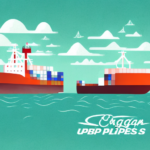Comparing UPS and FedEx for International Shipping: An In-Depth Analysis
If you're a business owner looking to expand your reach to the international market, one of the key considerations you'll need to make is shipping. When it comes to international shipping, two of the most popular carriers are UPS and FedEx. This article dives deep into their international rates, services, and reliability to help you make an informed decision.
Overview of UPS and FedEx International Shipping Services
UPS International Shipping Options
UPS offers a comprehensive range of international shipping services, including air freight, ocean freight, and customs brokerage. Their UPS Worldwide Express and UPS Worldwide Saver services provide reliable and timely delivery to over 220 countries and territories. Additionally, UPS integrates automated tools to streamline shipment management, enhancing efficiency for businesses.
FedEx International Shipping Solutions
FedEx is renowned for its fast and reliable express shipping services, making it ideal for urgent shipments. Their services, such as FedEx International Priority and FedEx International Economy, ensure delivery within 1-3 business days to most destinations. FedEx also offers specialized services like hazardous materials handling and comprehensive customs brokerage, catering to diverse business needs.
Key Factors Influencing International Shipping Rates
Distance and Destination
The distance between the origin and destination significantly affects shipping rates. Longer distances typically incur higher costs. Additionally, shipping to remote or rural areas may result in increased rates due to limited transportation options and extended delivery times.
Package Weight and Dimensions
Heavier and larger packages cost more to ship. Both UPS and FedEx calculate rates based on dimensional weight, which considers the package's size relative to its weight. Optimizing your package dimensions can lead to cost savings.
Service Type and Speed
The type of service chosen—such as overnight, express, or standard ground shipping—directly impacts the cost. Faster delivery options come at a premium, so balancing speed with budget is essential.
Customs Duties and Taxes
International shipments are subject to customs duties and taxes, which vary by country and product type. Both carriers assist with customs clearance, but these additional fees should be factored into your overall shipping costs.
Fuel Surcharges and Additional Fees
Fuel prices can lead to surcharges that fluctuate over time. Additionally, services like signature confirmation, insurance, and special handling may incur extra charges.
Cost Comparison: UPS vs. FedEx for Various Destinations
Standard Shipping Rates
For packages weighing 2kg with dimensions of 30x20x15cm, shipping to China, Canada, and the United Kingdom typically ranges from $60 to $85 for express shipping with both UPS and FedEx. [Source: UPS Rates, FedEx Rates]
Rates to Distant Locations
Shipping to countries like Australia or Brazil shows a noticeable difference. For instance, a similar package sent from the United States to Australia is approximately $50 cheaper with UPS compared to FedEx.
Bulk Shipping Discounts
Both UPS and FedEx offer discounts for bulk shipments. Businesses planning to send multiple packages should inquire about volume-based pricing to maximize savings.
Delivery Timeframes and Reliability
Express Shipping Delivery Times
Both carriers typically deliver express shipments within 1-3 business days, depending on the destination. However, specific routes may see variations, so it's crucial to compare estimated delivery times.
On-Time Delivery Performance
UPS boasts a 97% on-time delivery rate for international shipments, while FedEx reports a 96% on-time delivery rate. These high rates reflect their commitment to reliability despite the complexities of global logistics.
Tracking and Real-Time Updates
Both UPS and FedEx provide robust tracking systems, allowing businesses to monitor their shipments in real-time. This transparency helps in managing customer expectations and addressing any potential delays promptly.
Customer Service and Support
Accessibility and Responsiveness
Reliable customer service is paramount for resolving any shipping issues. UPS and FedEx both offer multiple channels of communication, including phone, email, and live chat, ensuring that assistance is readily available.
Quality of Support
FedEx is often praised for its responsive support team, while UPS is recognized for its comprehensive self-service tools and resources. Evaluating the quality of customer service can significantly impact your shipping experience.
Preparing Your International Shipment
Proper Packaging and Labeling
Ensuring that your package is securely packed and correctly labeled is essential to prevent damage and avoid delays in customs.
Accurate Customs Documentation
Providing precise customs information, including the correct tariff codes and product descriptions, facilitates smooth clearance and minimizes the risk of additional fees or shipment holds.
Adhering to Carrier Guidelines
Both UPS and FedEx have specific guidelines for packaging and shipping. Familiarizing yourself with these requirements helps in avoiding compliance issues.
Making the Right Choice for Your Business
Assessing Your Business Needs
Your choice between UPS and FedEx should align with your business requirements, considering factors like shipping volume, destination diversity, and budget constraints.
Evaluating Cost vs. Service Balance
Balancing cost with the quality of service ensures that you choose a carrier that meets your financial and operational expectations.
Long-Term Partnerships
Building a long-term relationship with a reliable carrier can lead to better service terms, discounts, and tailored solutions as your business grows.
Conclusion: Selecting the Optimal Shipping Carrier
Choosing between UPS and FedEx for international shipping depends on a multitude of factors, including cost, delivery speed, reliability, and customer service. By thoroughly evaluating these aspects and considering your unique business needs, you can select the carrier that best supports your global expansion goals while maintaining cost-efficiency.
For more detailed rate comparisons and service options, visit the official websites of UPS and FedEx.






















